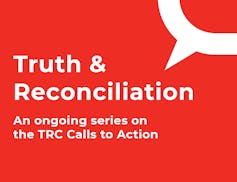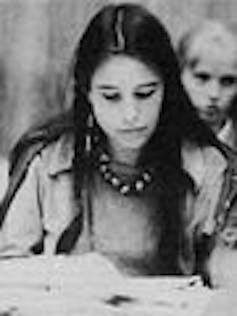Why misogyny needs to be tackled in education from primary school by Louise Mullany, University of Nottingham and Loretta Trickett, Nottingham Trent University
The issue of violence by men against women in UK society has once again taken centre stage. Public figures are beginning to talk about the more active role that men need to play in tackling this issue. In response to recent protests around women’s safety, policing minister Kit Malthouse has called for boys to be given compulsory school lessons on respect for women and girls.
We’ve been arguing since 2018 that education is key to addressing the issue of male violence against women, based on our study of the impact of Nottinghamshire Police becoming the first force in the country to record misogyny hate crime. This is a policy that the government now plans to implement nationwide. People of all genders who we interviewed told us that education and the role of men were both keys, and the younger education begins the better.
Misogyny: Boys Learn It
Global research on primary schools has shown that boys learn to behave in gendered ways that are reinforced by the adults around them. Teachers are a key part of this socialisation process. To change behaviour, we need to start with school.
Education needs to address a series of essential socio-cultural issues around gender, from power relationships and inappropriate language to touching and violence. The UK government, however, has been criticised for not having any clear strategy in place to do just that, which is why Malthouse’s statement is welcome.
In her book, Why Women Are Blamed for Everything, forensic psychologist and feminist author Jessica Taylor lays out some startling evidence presented to the UK Parliament’s Women and Equalities Select Committee. In secondary schools, only 3% of teachers felt confident to teach sex and relationships education.
A total of 40% of schools were found to have inadequate teaching provision in this area; 50% of children said they would not tell teachers if they were being harassed or sexually assaulted because they believed they would not be taken seriously.
Macho Heterosexual
Boys in the UK build their sense of masculinity in direct relation to the dominant “macho” heterosexual ideal of what it means to be a man. As sociology researcher R W Connell establishes in her book Masculinities, this dominant form is imbued with the most power in society and often translates into, among other things, language which demeans girls and their abilities, as well as violence and bullying. At school, this can mean boys controlling sports and playground areas, for example. Early primary school is the time where boys begin to distance themselves from girls and from behaviours stereotypically perceived as “feminine”, through put-downs and bullying. Current teaching guidelines, however, do not involve engaging younger children to think about their gender identities in any depth. They also do not facilitate detailed discussion among children on why they or their peers may engage in gender-based behaviours that are damaging to others.
 Later on in primary school, boys often define and display being a “real boy” through public projections of (hetero)sexual fantasies, and imagined (hetero)sexual futures as adults. This includes misogynistic objectification and sexualised forms of harassment towards girls and women. This can be a well-established part of their identities by ages 10-11, which then influences their behaviour as they move through adolescence into adulthood.
Later on in primary school, boys often define and display being a “real boy” through public projections of (hetero)sexual fantasies, and imagined (hetero)sexual futures as adults. This includes misogynistic objectification and sexualised forms of harassment towards girls and women. This can be a well-established part of their identities by ages 10-11, which then influences their behaviour as they move through adolescence into adulthood.
This age brings additional challenges, including increased peer pressure within the context of sexual development. The increased availability of pornography via the internet is particularly troubling, as research has shown greater porn use is associated with more sexist attitudes, behaviour and sexual violence.
What Schools Can Do
Throughout primary and secondary school, teaching children about respecting girls and women, and about the different forms misogyny can take should be compulsory. Currently, it is not.
Teachers need to be given the space in the PSHE curriculum, and the budgetary means, to put to use the growing number of educational strategies available. The creative industries offer resources to help with that kind of conversation. Our own graphic comic, Changing Minds, is a prime example for secondary schools and universities. It brings to life everyday stories of street harassment, told to us by women in our research interviews.
Boys also need male role models. In primary schools, where there is a lack of men, male teachers have a critical role to play in calling out sexist behaviours, however subtle they may appear. They also need to draw attention to issues of gender equality with everyone they work with so that boys can observe this in action.
The men in our research consistently reported they were either unaware that harassment was endemic, or that it had such an impact on the daily lives and freedoms of women and girls. If boys are enabled to recognise how damaging and pervasive gender stereotypes are to everyone in society, they can become allies, and call out similar behaviour among other boys – if they are backed up by adults.
Eradicate Violence Against Women And Girls
Schools can also work directly with external groups, including charities run by men, whose overall purpose is to eradicate violence against women and girls. The organisation Beyond Equality provides a compelling example of hundreds of men] currently working as volunteers in UK schools to educate boys. Through honest and open discussion, boys are taught to recognise how their behaviour towards women and girls might be detrimental, the long-term damage it can cause and, crucially, how to resist it.
For behaviour to change and misogyny to reduce, both education and men have essential roles to play. Our schools and teachers, as well as parents, youth groups, sports organisations, colleges and universities, need to be equipped with the tools and training needed to drive home the message that abuse of women and girls – under any guise – is completely unacceptable.![]()
Credits
Louise Mullany, Professor in Sociolinguistics, University of Nottingham and Loretta Trickett, Senior lecturer, College of Business Law and Social Sciences, Nottingham Law School, Nottingham Trent University
This article is republished from The Conversation under a Creative Commons license. Read the original article.

 Lesson 2: Taking Risks
Lesson 2: Taking Risks Modern medicine and public health have traditionally focused on figuring out the origins of disease and how to prevent poor health.
Modern medicine and public health have traditionally focused on figuring out the origins of disease and how to prevent poor health. This is a wish come true on a personal level. It was a wish for a woman to be in my life that would truly guide me to the white picket fence life. Waited for many moons and that was not happening – the white picket fence life. The journey through the valley was made with the hope in my heart that there was a purpose through it all.
This is a wish come true on a personal level. It was a wish for a woman to be in my life that would truly guide me to the white picket fence life. Waited for many moons and that was not happening – the white picket fence life. The journey through the valley was made with the hope in my heart that there was a purpose through it all.
















 International standards of justice require that those responsible for human rights violations must do more than acknowledge and apologize for the harm that has been done. They must go further. They must take every reasonable measure to set things right and to prevent any recurrence of harm.
International standards of justice require that those responsible for human rights violations must do more than acknowledge and apologize for the harm that has been done. They must go further. They must take every reasonable measure to set things right and to prevent any recurrence of harm.
 Refuting The Doctrines Of Racial Superiority
Refuting The Doctrines Of Racial Superiority Reconciliation: Much Work Needs To Be Done
Reconciliation: Much Work Needs To Be Done Young People. ‘Maple Spring’
Young People. ‘Maple Spring’ Can Influence Election Outcomes
Can Influence Election Outcomes Making A Difference – One Youth At A Time
Making A Difference – One Youth At A Time The Explainer
The Explainer Age and Magico-Religious Beliefs
Age and Magico-Religious Beliefs Increased Awe For Elderly Women
Increased Awe For Elderly Women Life Is A Game And You Are The Captain
Life Is A Game And You Are The Captain The Three Steps: Check Your Players’ AIM
The Three Steps: Check Your Players’ AIM